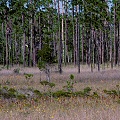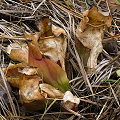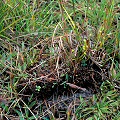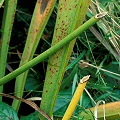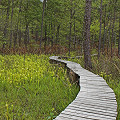Q: Sarracenia conservation status.
A: I think that it is useful, when talking about Sarracenia
conservation, to think about three general cases.
Case 1: Relatively common species
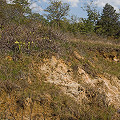 Texas
Texas
erosion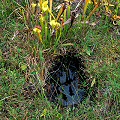 North Carolina
North Carolina
poaching hole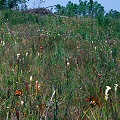 S. leucophylla: dying
S. leucophylla: dying
at a ditched site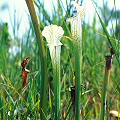 S. leucophylla: happy
S. leucophylla: happy
at an intact site
Most of the species (or infraspecific taxa) occur over fairly large ranges with at least 50 or more sites remaining. Such plants are considered relatively secure from extinction because they still occur in dozens of areas, many of which are set aside for conservation. Even so, these plants are rapidly becoming rarer in the wild for the usual reasons: habitat destruction (plantations, golf courses, or residences); habitat fragmentation; changes in water quality (runoff or groundwater contaminated with herbicides, pesticides, other pollutants); or siltation; changes in hydrology (because of drainage tiles or ditches); modified fire regimes (usually fire suppression); and invasive species.
I regularly hear about sites being destroyed. It is heartbreaking. But what can you do? Humans will continue to reproduce, sites
will continue to be destroyed. We have to put our resources into protecting the sites we can, and must be philosophical about
the destruction. We have already lost 95% of our wetland habitat in the USA; expect to see more go.
Yes, we are going to lose almost all our remaining pitcher plant lands in the US within our life spans, but at least with
effort we can keep a few sites in existence.
This is similar to how philosophical we would have to be if super-powerful
alien invaders landed on Earth and told us that they were going to
kill everyone on the planet except for a few million people who would be allowed to live in a small patch of land on one of the
continents.
Compared to such massive habitat destruction, poaching by hobbyists is not as serious a threat.
However, the rare but persistent poaching events make conservation workers distrust carnivorous plant enthusiasts!
Case 2: Rare to critically endangered species
Once we have destroyed so many pitcher plant sites that fewer than 50 sites exist, the situation is one of crisis management.
Sarracenia alabamensis subsp. alabamensis, S. jonesii,
S. oreophila, and S. purpurea var.
montana are all in this category. For such plants action must be taken to decrease further degradation of
the remaining sites. Fortunately, all the sites for these plants are well known by conservation organizations and management plans are
in place. However, it is often hard to fund these management plans.
When situations get this bad, any damage is extremely bad news. Something happening to even a single site,
such as a pollution spill near a nature preserve, represents a serious conservation setback. Poaching by carnivorous plant
horticulturists is extremely damaging and resented. Managers for pitcher plant bogs tend to know each other, so news
of poaching travels quickly. Because of poaching, conservation workers do not even like to talk about their sites when
carnivorous plant enthusiasts are around. This is too bad, since carnivorous plant enthusiasts should be allies in conservation,
and not foes! But can you blame the conservation workers? Wouldn't you resent it if you were robbed, and then you saw your goods being
sold on eBay?
If you still want to complain about the limitations placed on Sarracenia cultivation by the Endangered Species
Act, reflect upon the fact that the habitat for (unprotected) Sarracenia leucophylla is being destroyed at lightning
speed, while the Federally protected species are largely--but not completely--insulated from habitat destruction.
Case 3: Politically rare entities
Because of state and county boundaries, some species have the heightened appearance of being very rare. For example, despite its
greater populations in other states along the Gulf Coast,
Sarracenia psittacina is only found in two parishes in eastern Lousiana, and therefore is considered very rare
in Louisiana. Similarly, while
Sarracenia leucophylla occurs at numerous sites in Florida, Alabama, and Mississippi, it
is only found at one place in Georgia. These perceptions of rarity
are artifacts of political boundaries. If Alabama and Georgia were merged, we might think a lot less of that
Sarracenia leucophylla population in Georgia.
There is validity to being concerned about populations that occur in outlying sites---such distant populations may represent
plants with distinct characters, or might serve as refugia if diseases attack the main populations. But it is important to remember
not just the state rarity of an organism, we should remember
the global rarity too. These factors help us when we are deciding how to allocate our time and effort.
The role of horticulture and trade
Carnivorous plant enthusiasts should want to help in the conservation of Sarracenia. Unfortunately,
because of the continuing history of poaching, it is very difficult for horticulturists to even get a seat at the table
when conservation is being discussed. However, there are some things that horticulturists can and have been doing.
1)It is gratifying to see that horticulturists are increasingly aware that poaching is harmful to carnivorous plant populations.
This awareness should increase. Resolve not to buy poached plants. Learn about reliable dealers via internet forums; this is easier than
ever before.
2)Support established
conservation programs. The Nature Conservancy (TNC), the
International Carnivorous Plant Society (ICPS), and local nonprofits such as Atlanta Botanical Gardens (ABG) are all established entities
that are involved in conservation. The North American
Sarracenia Conservancy is focused on protecting plants in the genus.
Donate to their conservation programs. TNC is huge (by conservation group
standards) and is doing amazing work at carnivorous plant sites throughout the USA. ABG has a program focused
on rare pitcher plant sites.
The ICPS has had a number of active programs, although I think that most of these have been ended in favor of supporting research grants.
In the past, it had a grant program and supported
targeted projects by ABG and TNC to help protect several species of Sarracenia. The ICPS also
worked with Federal agencies, conservation partners, and its membership to legally distribute plants that are otherwise difficult to obtain
because of trade restrictions. If you want it to re-energize those projects, you should contact the ICPS and make your wishes known!
3)Stay legal! In the USA, three species of Sarracenia are protected by the
Endangered Species Act.
Internationally, the same species are listed on Appendix I of
CITES, while all the remaining species are listed
on Appendix II. If you grow and trade Sarracenia, you should know if these affect you.
Emerging concerns
There are additional concerns that we have to worry about to some degree, since they are new things on our horizon.
1)Cut pitchers: There is still interest in the florist trade
for cut pitchers of Sarracenia. Usually the species
is Sarracenia leucophylla. As far as I know, there are no sustainable cut-pitcher farms, and all the
pitchers for this are from wild-cut sources. Although this may be done legally with appropriate permits, I do not think that the
practice is being done properly. The floral trade will probably push S. leucophylla closer to
extinction because of that species' beautiful leaves.
2)Global Climate Change: Yes, this is occurring, and occurring big time. We are seeing organisms move northward. In
Sarracenia purpurea, the larvae of the mosquito Wyeomyia smithii are
changing their life cycles to accommodate climate changes. Sea water levels are rising in the Gulf Coast. While plants
might have been able to migrate in previous climate changes, the current climate changes are very rapid and, most importantly,
there are not enough intervening natural sites for plants to migrate to!
Page citations: Bradshaw, W.E. & Holzapfel, C.M. 2001;
CITES, 1992; Determann, R. 2000, private communication; Murdock, N. 2000, private communication;
Rice, B.A. 2006a; Schnell, D.E. 2006a;
Simpson, R.B. 1994; US Fish & Wildlife Service, 1973. .
